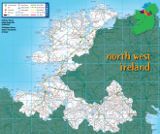North West Ireland Tourism
Visitor Guide to Mayo, Sligo, Donegal, Roscommon, Leitrim, Cavan & Monaghan
Visitor Guide to Mayo, Sligo, Donegal, Roscommon, Leitrim, Cavan & Monaghan
| 0-9 A B C D E F G H I J K L M N O P Q R S T U V W X Y Z |
Arranmore Island
A spectacularly beautiful island of the west coast, Arranmore Island is a wild and rugged place with incredible cliff views dramatic sea caves and golden sandy beaches. Arranmore is situated in a Gaeltacht (Irish speaking area) approximately three miles off the Donegal coast. The island is serviced throughout the year from the fishing village of Burtonport by a regular ferry service.
The journey from Burtonport to Arranmore follows a wonderfully scenic route between a number of small islands, before crossing the short stretch of open Atlantic known as the “Arran Roads”. The narrow channel between Rutland Island (Inis Mhic an Doirn) and Inishcoo (Inis Cú/Ederinish) Island is known as “The Black Hole” due to its deep, dark, fast moving waters. The shelter provided by the islands allows the Ferry to run in all but the most severe weather conditions and the crossing only takes 20 minutes.
With an area of ten square kilometres, Arranmore is the largest of the Donegal islands, and the second largest inhabited island of Ireland. Before the Flight of the Earls at the start of the 17th century, the island was controlled by the O’Donnell Clan (of Donegal Castle) and was known as “Ára Uí Dhomhnaill” which means “O’Donnell’s Arran”. During the 17th century Plantation of Ulster the island was granted to Lord Conyngham, as indeed was much of north west Donegal at that time. It was during his ownership of the Island, a place he never even once visited, that many of Arranmore’s people were forced to leave because of the Irish Famine. Many died on Arranmore, many in the tragic poorhouse in Glenties, and even more aboard the horrendous “coffin ships” as they made the journey across the Atlantic to America and Canada.
Today a beautiful handmade stone “Marian Shrine” commemorates the Arranmore people who left the island during those tragic times. The sign beside the Marian Shrine reads, “Emigration has been part of life for the people of Arranmore Island for hundreds of years. Many who made the journey across the Atlantic settled on Beaver Island in the Great Lakes of the U.S.A. Of the 881 residents in 1880, there were 141 Gallaghers, 123 Boyles, and 90 O’Donnells recorded in the Census. Strong links are retained today between the people of the two islands. The memorial at this site commemorates these links”. These days the population of the island has marginally increased to around 900 people.
The proximity of Carrickfinn International Airport (25 minutes by car to Burtonport Pier) makes Arranmore an ideal destination for weekend and short break.
Arranmore Ferry
Tel: +353 (0)74-9520532
Web: www.arranmoreferry.com
Book Arranmore Island Accommodation
View Islands of North West Ireland in a larger map
The journey from Burtonport to Arranmore follows a wonderfully scenic route between a number of small islands, before crossing the short stretch of open Atlantic known as the “Arran Roads”. The narrow channel between Rutland Island (Inis Mhic an Doirn) and Inishcoo (Inis Cú/Ederinish) Island is known as “The Black Hole” due to its deep, dark, fast moving waters. The shelter provided by the islands allows the Ferry to run in all but the most severe weather conditions and the crossing only takes 20 minutes.
With an area of ten square kilometres, Arranmore is the largest of the Donegal islands, and the second largest inhabited island of Ireland. Before the Flight of the Earls at the start of the 17th century, the island was controlled by the O’Donnell Clan (of Donegal Castle) and was known as “Ára Uí Dhomhnaill” which means “O’Donnell’s Arran”. During the 17th century Plantation of Ulster the island was granted to Lord Conyngham, as indeed was much of north west Donegal at that time. It was during his ownership of the Island, a place he never even once visited, that many of Arranmore’s people were forced to leave because of the Irish Famine. Many died on Arranmore, many in the tragic poorhouse in Glenties, and even more aboard the horrendous “coffin ships” as they made the journey across the Atlantic to America and Canada.
Today a beautiful handmade stone “Marian Shrine” commemorates the Arranmore people who left the island during those tragic times. The sign beside the Marian Shrine reads, “Emigration has been part of life for the people of Arranmore Island for hundreds of years. Many who made the journey across the Atlantic settled on Beaver Island in the Great Lakes of the U.S.A. Of the 881 residents in 1880, there were 141 Gallaghers, 123 Boyles, and 90 O’Donnells recorded in the Census. Strong links are retained today between the people of the two islands. The memorial at this site commemorates these links”. These days the population of the island has marginally increased to around 900 people.
The proximity of Carrickfinn International Airport (25 minutes by car to Burtonport Pier) makes Arranmore an ideal destination for weekend and short break.
How to get to Arranmore Island
By car, bicycle, foot, or ferry. The car ferry to Arranmore departs from Burtonport Harbour every hour during the summer months, and the crossing takes just 15 minutes. Pre-booking is advisable on summer weekends.Arranmore Ferry
Tel: +353 (0)74-9520532
Web: www.arranmoreferry.com
Explore more
Arranmore is accessed by way of Burtonport which is itself surrounded by beautiful coastal towns. Don't miss Kincasslagh and Bunbeg if you are travelling north, and Rossbeg and Ardara if you are travelling south.Where to Stay on Arranmore
Arranmore has a good range of accommodation types, from hotels, to guesthouses, holiday cottages, and B&B's.Book Arranmore Island Accommodation
Things to do in Arranmore Island.
- The walk around Arainn Mhor (Arranmore) is sign posted as Sli Arainn Mhor (part of Bealach na Gaeltachta which is a National Waymarked way) and begins and ends at the Ferry Port. The views in all directions along that walk are stunning and the western half of the route is particularly remote. Enjoy!
- The crystal-clear waters surrounding Arranmore provide great dive sites and sea angling, while the island’s freshwater lakes are home to brown and rainbow trout. Boats for sea angling can be hired and there are abundant cod, ling, conger eel, pollock, wrasse, skate, turbot and plaice. Birdwatchers will enjoy seeing fulmars and shags and climbers can tackle the steep cliffs.
- Explore local craftwork in the local shops, selling a high-quality range of locally crafted items including the famous Aran knitwear.
Arranmore Island Map
View Islands of North West Ireland in a larger map
Related Categories






